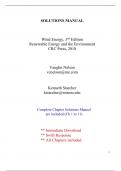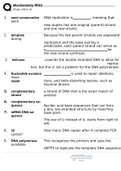SOLUTIONS MANUAL
Wind Energy, 3nd Edition
Renewable Energy and the Environment
CRC Press, 2018
Vaughn Nelson
vcnelson@me.com
Kenneth Starcher
kstarcher@wtamu.edu
Complete Chapter Solutions Manual
are included (Ch 1 to 11)
** Immediate Download
** Swift Response
** All Chapters included
1
,Chapter 2
Questions/Activities
1. Date US population World population
3/29/2018 327,438,000 7,463,155,000
Answers from previous years are given to show how population is increasing.
6/1/2013 315,975,000 7,089,412,000
1/27/2008 303,318,773 6,646,783,764
9/26/2005 297,269,083 6,468,918,642
9/13/2003 292,062,965 6,317,360,874
2/17/2002 286,470,333 6,206,243,040
2. Nelson: A. Drive the speed limit. Drive 10 km/hr (5 miles/hr) below speed limit on highways
with 75 and 80 mph limits. Purchased electric vehicle, Nissan Leaf, in April 2012, for urban
driving, Traded for new Leaf 2017, longer range 160 km; average 5.8 km/kWh (3.6 miles/kWh),
equivalent to 30 km/liter (115 miles/gal).
B. Turn off lights in the house when not in use or when we leave the home. C. For replacement
bulbs, buy LED’s.
Starcher: Ken you need to fill in your answer.
3. For 2017, Oil 97.7 million bbls/day = 35,7 Gbbl/yr.
Coal 5.4 Gtons
Past numbers:
For 2012, Oil 89 million bbls/day = 32.4 Gbbls/yr.
For 2008, 86 million bbls/day = 31.4 Gbbls/yr.
For 2011, Coal 7.7 Gtons.
For 2008, 6.4 Gtons
4. Energy and temperature are different. Proton has very little energy while cup of coffee will
result in injury.
Proton: for physics majors, E = (3/2) kT, where k = Boltzman’s constant, T = deg K
E = 1.5 * 1.4*10-23 (J/oK) * 1*106 oK = 2 * 10-17 Joules
Or assume it is traveling fast, speed of light 3*108 m/s
KE = 0.5 mv2 = 0.5 * 1.7*10-27 * 9*1016 = 7*10-11 Joules
Cup of Coffee: Vol = 0.25 liters = 250 cubic centimeters of water at T = 80 oC = 353 oK
Energy of one atom = 3/2 kT = 1.5 * 1.4*10-23 (J/oK) * 353 oK = 7.4 * 10-21 J
Avagardo's number = 6*1023, # of atoms in 18 gm of water.
So for 250 gm of water, energy = (250/18) * 7.4*10-21 J * 6*1023 = 6*104 J.
No comparison, you DO NOT want to put your finger in the cup of hot coffee.
Another way is to calculate heat stored in cup of coffee: Assumption from 25 oC to 80 oC, mass
(m) = 250 grams, c = heat capacity of water 1 cal/(gr oC)
Q = mc[T(final) - T(initial)] = 250 gm * 1 cal/(gr oC) * (80 - 25) oC = 1.4*104 calories
Conversion 1 cal = 4.18 Joules
Q = 6*104 Joules
2
, 5. The incandescent light bulb is too hot to touch, while the fluorescent bulb is cooler. Light
output is around the same. That is why there are regulations to phase out incandescent light
bulbs.
Problems
1. m = 0.5 kg, v = 10 m/s
KE = 0.5 mv2 = 0.5 * 0.5 * 102 = 25 J
2. 10% growth rate is a doubling time of 7 years. 5 doubling times = 35 years.
Can do by doubling times, starting with 100,000.
200,000; 400,000; 800,000; 1,600,000; 3,200,000
Or 5 doubling times = 25 = 32. So number is 32*100,000 = 3,200,000 people
3. k = 0.5%, DT = 69/0.5 = 138 years.
4. You have to assume or obtain a growth rate for population. I chose 1%, which gives a
doubling time of 69 years. Round to 70 years. Present population 7.4*109
2018 7.4*109
2088 15*109
2158 30*109
5. March 2018; there are 7.4 billion people in the world. You have to assume or obtain a growth
rate for population. Growth rate is 1.2%.
To calculate directly use Eq. 2.7. k = 0.012, t = 82 (2100-2018), kt = .984
r = 7.4*109 * e0.0984 = 7.4*109 * 2.67 = 20 billion people
If you chose a smaller growth rate, 1%, the results are much the same.
Estimate using doubling time. DT = 69/1.2 = 57 years
At 2075, 14.8*109 and at 2132, 30*109 people, so at 2100, estimate 19 to 20*109 people.
6. Use Eq. 2.7 and solve for time; 30*109 = 7.4*109 * e0.005t
4.1 = e0.005t take ln of both sides. ln 4.1 = 0.005t; 1.4 = 0.005t
then t = 280 years.
Or use doubling times. DT = 138 years. So 2 DTs is 276 years for 40*109 people.
7. Stabilization point = 10*109, increase in population = 3.6*109
3600 million/20 million = 180 new cities the size of Mexico City. Can you imagine the
infrastructure problems for building that many new cities?
8. 7% growth rate, k = 0.07, DT = 10 years
Electric generating capacity in U.S. = 1,400,000 megawatts
50 years is 5 DTs
1,400,000 2,800,000 5,600,000 1,120,000 22,400,000 44,800,000 MW
Amount of new capacity = 44,800,000 - 1,400,000 = 43,400,000 MW
# of 1000 MW plants = 43,000
3





